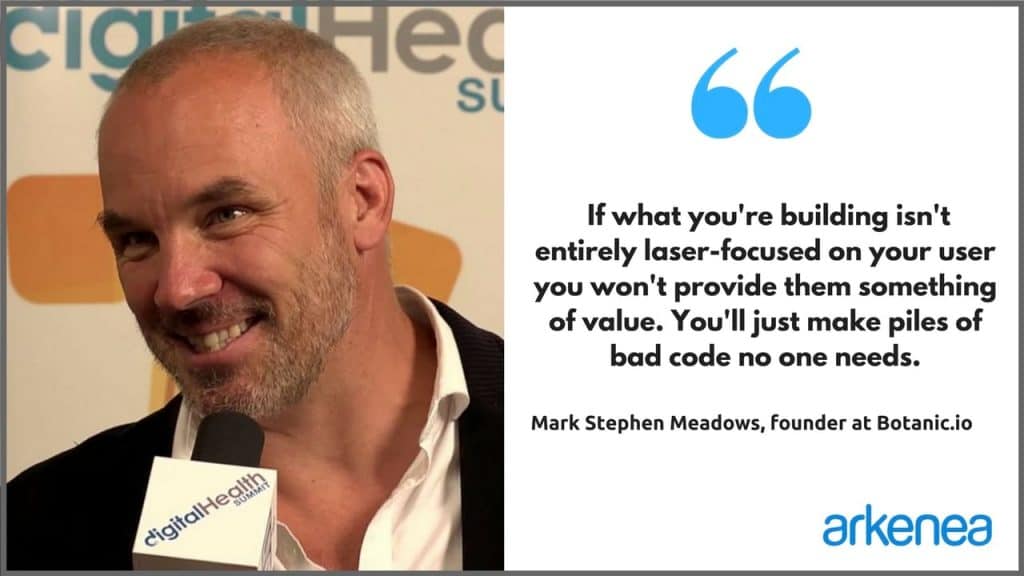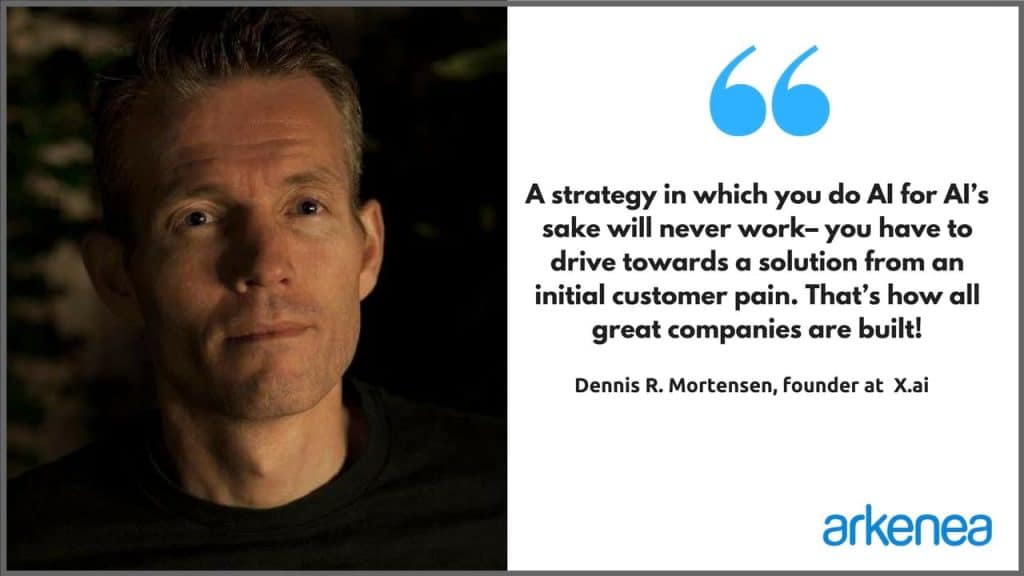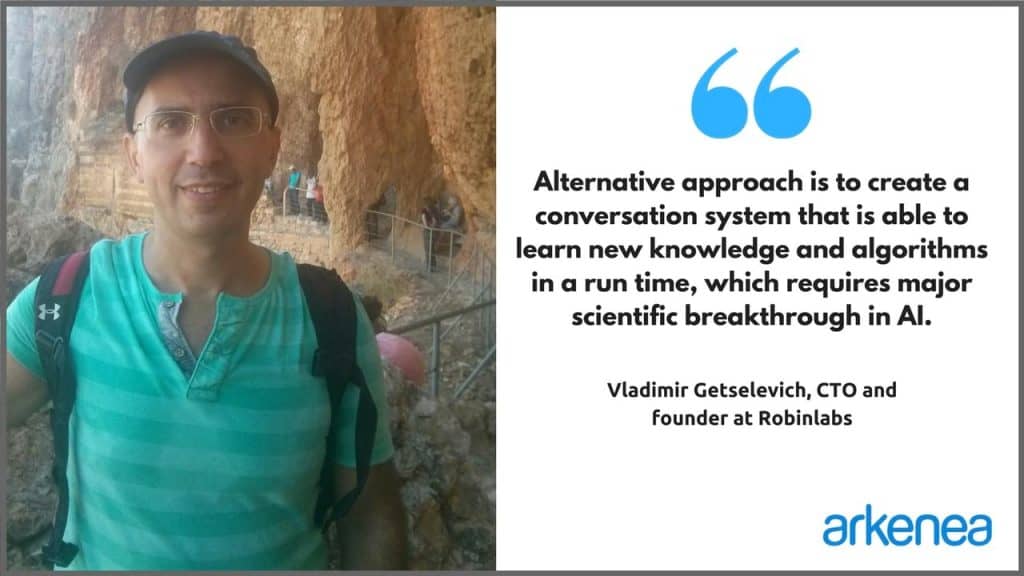Developing an AI (Artificial Intelligence) app? Then you would want to hear from 7 founders that have built and scaled AI apps to success.
While talking to these 7 founders and many others in the Artificial Intelligence industry, we heard many common themes. But one almost always stood out – don’t get too consumed by the technology itself, and pay attention to the real human problem you’re solving. Be human with your AI app.
There’s, of course, much more to the advice with deeper insights into what it takes to build a successful AI app, such hiring the right AI development company. So here are 7 founders in their own words, what it takes to develop a successful AI or Artificial Intelligence app.
#1 Focus on the cultural implications

Mark Stephen Meadows, founder at Botanic.io
Research your user: If you don’t know your user you don’t know the tool’s use. If you don’t know the tools’ use you won’t know what APIs or web-hooks to use. If what you’re building isn’t entirely laser-focused on your user you won’t provide them something of value. You’ll just make piles of bad code no one needs.
The UX is key: UX is what allows an end-user to know the value of the system and how to interact with it. Cortana, Siri, and Alexa have bad UX. Proof that Alexa has bad UX can be seen when you research how people are using it: 85% of its use is to play a song. Alexa has thousands and thousands of functions but people don’t know how to access them or even what they are. That’s bad UX.
The UX to AI is personality: Personality is a combination of form and function, not a silly garnish or pithy joke. The use flow and the dialogue management structure have to be designed together. We use personality templates that are archetypes of people in that service industry (CPA, nurse, life coach, etc) and then we tweak them, but it takes heavy front-end research and intentional design to make a bot that doesn’t suck.
Quantity is Quality: At least today with ML and RL functions that lean on big data. In terms of natural language we multiplex top-down systems (chatscript, rive, AIML) with bottom-up systems (LUIS, Lex, Watson, etc). The goal is to make sure that the bulk of the responses are ready to reply to the bulk of queries, and so the more of them you can load in the better. And make sure that you work with linguistic black-belts, like poets, authors, playwrights, that way you have a qualitatively superior quantity.
Test it, and test it, and test it, and test it: Chat log reviews are key and should be done on a daily basis. Track them, identify where the key responses are mis-firing, where false-positives are hitting, and why. Iterative builds are a must here and expect that your bot is something you continually improve, refine, expand, and improve. Learn from your mistakes. Improve your libraries, tighten integration, float responses higher up the flow so that people know what they can do when. All those decisions come from testing.
Nobody wants to talk with a robotic robot: And we don’t need more people, either. So build a system that represents the end-users’ values, treats them with dignity and respect, and helps them in a humane manner. Put personality over technology, prioritize personal attention over automation, and use tools to make the character believable.
Avoid the uncanny valley not only of appearance but of psychology, social interaction, and response style.
Artificial Intelligence is based on “artifice”: AI is more cultural than technical. The word “artificial” is based on artifice, which is based on art, which is cultural. I have no clue what intelligence is but it might be the ability to predict, to identify patterns, and to engage in social dynamics. Don’t focus, therefore, on the engineering, focus on the cultural implications.
Related:
#2 Adopt a human-centered approach; don’t forget UX

Gianluca Maruzzella, co-founder & CEO at Indigo AI
We at Indigo AI strongly believe that AI-powered chat-bots will change customer experiences forever, delivering wow moments that were not quite possible before. But this change – enabled by AI – will be possible only if we will design adopting a human-centered approach.
Look around, how many chat-bots do you remember as significant to you? There are plenty of chat-bots that do not provide any added value. This is why people who are involved in building these applications often are only tech-driven and they eventually forget users and their real needs.
But it’s not an AI fault: it’s all about bad design. If you want to build a great app you should know that – except for some exceptional use case – the tech know-how is a point of parity. A good design, both in terms of service and experience, is the key to build successful AI app, driving satisfactions and delight to final users.
So, how to build great AI app? Find something useful and never forget users.
Takeaways: don’t forget UX; even if you are planning to build something that you believe is a game-changer, start always thinking about the basic needs and connect with people’s habits; focus on interactions with your users; keep in mind that personalization is the main driver of success; eventually your goal is to build emotional connections. We are humans, after all.
#3 Drive towards a solution from an initial customer pain

Dennis R. Mortensen, founder at X.ai
Focus! Not as a catchword, but in the most extreme sense. It’s easy to get distracted, especially if you have some early customers or potential partners clamoring for features.
You have to figure out the one thing you can excel at and relentlessly drive towards that.
A strategy in which you do AI for AI’s sake will never work– you have to drive towards a solution from an initial customer pain. That’s how all great companies are built!
At x.ai we do one thing and one thing only: schedule meetings. Our AI assistants Amy and Andrew were born out of the pain that faces 99% of knowledge workers who do not have a human personal assistant, who have to deal with the frustrating and time-consuming task of scheduling meetings.
To solve this pain, we developed Amy and Andrew to take over this task entirely. We see a huge opportunity out there for vertical AI, autonomous agents that focus on a single job and perform it from start to finish.
#4 Go in-depth in more limited but useful vertical domains

Vladimir Getselevich, CTO and founder at Robinlabs
I will answer from my years of experience in developing conversational personal assistants and chat-bots.
The conversation is very natural interface for people to have interaction with machines, therefore the curiosity and the expectation are great.
At the same time, the range of topics that different users may think of is very broad, almost unlimited. And the context and possible dialog branching of different scenarios is also huge.
So, for now it is almost impossible to satisfy such a demand in a general kind of assistant. The only way is to go in-depth in more limited but still useful vertical domains. Or alternative approach is to create a conversation system that is able to learn new knowledge and algorithms in a run time, which requires major scientific breakthrough in Artificial intelligence.
#5 Attention to human benefits is more important now

Jack C. Crawford, founder & CEO at Datalog.ai
When developing an advanced software product for human use, it’s best to start with the challenges that people face every day. Understanding daily “jobs” is the first place I look for opportunities where AI can make a difference.
It’s where we can all find ways to employ amazing technology to make lives easier and better. With an increasing pace of advancements in AI, attention to human benefits is more important now than ever.
#6 Make sure that the data that you collect is top notch

Jacob Shama, CEO & co-founder at Mintigo
When developing an AI platform, one of the most important thing to keep in mind is the quality of the underlying data. In AI, data is everything… Avoid situations of garbage in, garbage out. Even if you have great predictive models, wrong data will deliver the wrong results.
This is why at Mintigo we spent a significant amount of time, talent and resources in making sure the data that we collect from the web is top notch. This is the secret sauce behind our models’ ability to make stellar predictions and bring incredible value to our customers.
#7 Understand the interaction between app and the user

Trevor Jackins, marketing specialist at NeoSpeech
It’s important to understand how the app and user will interact with each other. You can have the smartest, most brilliant AI app in the world, but if it’s unable to effectively communicate information to the user or the user has trouble interacting with the app, then it is worthless.
Do not overlook the value that high quality Text-to-Speech and Speech Recognition features can bring to your AI app, and understand beforehand how the app and user will interact with each other.
